
We are not a technical review site. We are people who love travel, love movies, and love projectors. We are on a road trip with the new BenQ GV1 portable projector.
We have had this projector with us on the road now for three months. I (Nick) drafted an earlier edition of this review after we had had it for a week and at that time I had very little good to say about this machine because of connectivity frustrations. Now after 3 months of using it we have come to terms with its quirks, we love our mobile movie nights which wouldn’t be possible without our GV1. Do we love the BenQ GV1 projector? Read on.
BenQ GV1 Review Summary
The BenQ GV1 calls itself a Portable Projector, but as far as movies are concerned, it would better be described as a Player Projector. By that I mean to watch a movie, you first load the video file onto a special flash drive and play it through the VLC media player app on the GV1’s Android system. You can’t link it to a laptop and play the movie through the projector. This is fine, but it took a lot of trial and error to find a way of optimising this – so here is the benefit of our experience to save you the learning curve.
It is also unreliable. The first unit we had failed after a few weeks by not communicating with the remote. The battery on the replacement unit has failed after a couple more months – meaning it won’t hold a full charge for more than a day – a big issue if you are on the road away from mains power!
The upside is a big one: The Benq GV1 sits on the table entirely unconnected to any cables at all and shows a movie with a big bright picture on the wall or a suspended bed sheet. The downside is that it rather falls between two stools. The image quality and sound arrangements are not good enough for home theatre use and after having explored all the connectivity options the only way to use it for travel away from Wifi is to buy a USB-C flash-drive onto which video files are loaded from a laptop.
Summary of specifics
(5 is best 0 is worst)
| Overall assessment and value for money | 2 |
| Reliability | 2 |
| Look and feel of supplied hardware | 4 |
| Special award for providing the fun facility ofbig screen movie nights that we couldn’t have on the road otherwise | 4 |
| Documentation | 2 |
| Operating system functionality and ease of use | 3 |
| Quality of still image given the comparatively low 480 resolution | 5 |
| Quality of image for watching movies | 3.5 (low res and some formats give jerky video) |
| Quality of internal sound | 3.5 |
| Quality of audio transmitted through bluetooth | 3 (lip-synch issue) |
| Connectivity while on home network with broadband or server | 5 |
| Special award for nice-to-have apps that don’t exist which might make up for operational frustrations: | 0 |
| Frustration quotient awarded for non-bundled essential hardware | 1 |
Please read our disclaimer at the end of the post
About Us and Projectors.
We have been fans of projectors for more than a decade, and in that time we have never had a TV. For us both at home and at work BenQ projectors have shone through for consistent quality of hardware and performance. So it was natural for us when planning our road trip that we asked BenQ if they would like to supply one of their new GV1 portable projectors to take with us. The plan was to enjoy open-air movie nights projected onto a bedsheet under the stars.
We have never used computers or projectors for gaming, so you won’t find anything about that here. Nor do we have a need for powerpoint presentations. We use our projectors 95% for commercial movies kept on hard drives and 5% for photo slideshows.
In terms of our tech-savvyness, Nick is a DELL/PC and Android guy and Ania has a Macbook pro and an iPhone. At home we have a network with Iomega and Synology NAS fileservers and we carry a few iPads so we have tried the BenQ GV1 projector in various modes.
Overview of Our First Impressions with the BenQ GV1
Good things first:
- It’s a nice looking and physically robust piece of kit (though I don’t intend dropping it to check)
- When hooked up to a new USB-C flash drive, our home media server or broadband internet for YouTube, or streaming services it gives a great picture for colour and contrast.
- The built-in speaker gives acceptable sound in a smallish space (eg inside our campervan)
- It sends a clear audio signal to our portable Bose Bluetooth speaker which can be placed below the screen for better sound. Though there is now a lipsynch delay we can’t shake off.
Fortunately the machine arrived a week before we left for our six month road trip. I say fortunately because it took us a week of trial and error before we got the machine working as we would need it while away from home. But when we bought a USB-C pendrive to deal with the unit’s connectivity quirks, we at last got on the road for our mobile movie nights.
After watching half a dozen movies on the road, the machine broke down. BenQ kindly provided a replacement unit and asked us to return the original for their post-mortem. We have not received any report from them about that.
What is the BenQ GV1?
It’s an internal-battery-powered portable DLP projector-player smaller than a house brick and weighing three quarters of a kilogramme, with an LED lamp. Throw ratio is 1.3:1, Resolution 480p (aka WVGA) contrast ratio 100k:1.

In my book everything there is good to very good except the resolution, which is equivalent to a DVD, not Bluray, however for mobile use and a screen width of say 1.5m it’s great. The colour and contrast are nice. The brightness is fine for a dark environment when on battery power.
But it doesn’t work like any other digital projector I have ever used. ie you can’t play a movie on your laptop and project if from this unit (actually you can, but the results are terrible as described below). The only way we could get it working while away from our home Wifi with an image of reasonable quality was to load movies onto a new USB-C pen-drive and let it play those movies itself.
It comes with a power supply and charger which can plug into anything from 110-240v AC with adaptors to match. The battery claims a 3 hours functional life I’m not sure if it last so long but we can watch a whole movie without charging it.
Edit three months later: the battery doesn’t hold a charge. It can be fully charged overnight, and if it’s not used that day, next time you pick the machine up, it is dead. Noting that this was a replacement unit after the first one failed this makes it unacceptable, especially for life on the road for which we were testing it.
Unboxing
The stuff in the box is fine so far as it goes, especially the multi adaptor and wide voltage range of the power plug. There is a cute and easy-to-lose little remote (don’t lose it though because it is the only way to access the controls) There is a cable, one end of which connects to the USB-C port and the other end of which connects to no piece of hardware I have ever owned. There is a quickstart guide and a drawstring bag.
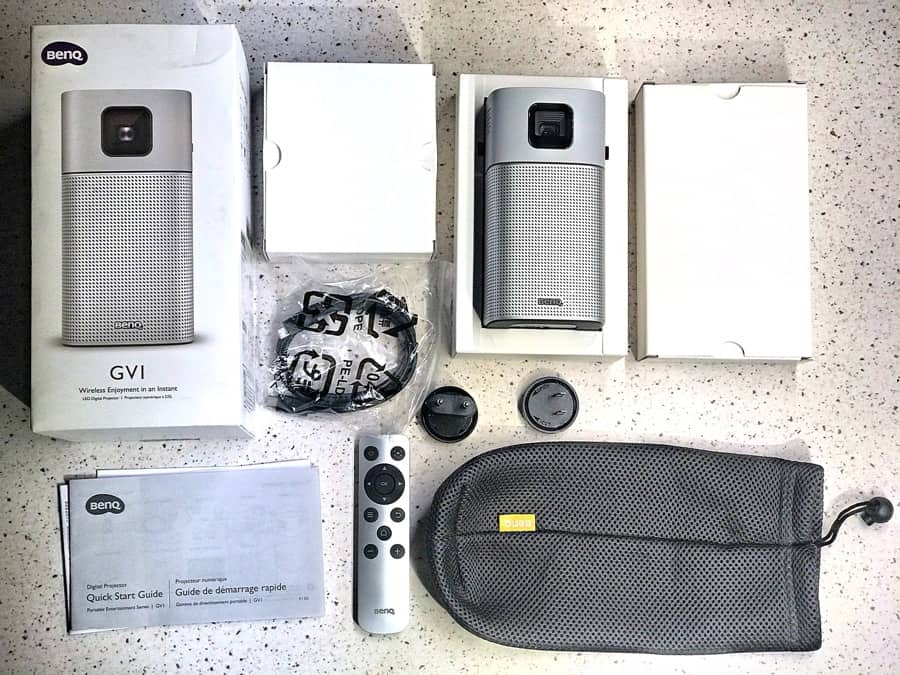
The stuff that isn’t in the box but should be is very significant – I’ll come back to that below.
Look and Feel
The unit is stylish and chunky. There seems to be some autofocus not described in the documentation which sometimes makes physical focus adjustment behave strangely but with a bit of fiddling it focuses fine. Not enormously sharp, but good enough for the 480p resolution – ie you can just see the pixels. There is an internal fan which is pretty quiet.
The default full brightness and “Vivid” colour setting is nasty and harsh, but switch to battery power lamp setting and “Cinema” colour mode and the unit gives lovely colour and plenty of contrast when projected against a bedsheet or white wall in a darkish room.
The sound from the internal speaker is unexciting (worse than my laptop) but that shouldn’t matter much, because who wants audio coming from the projector anyway? It gives great sound through our Bose Mini II Soundlink bluetooth speaker placed under the screen, though of course now there is a significant lip-sync lag. Fortunately VLC media player downloaded from Aptoid (see below) has a fix for this called Audio Delay. Unfortunately it doesn’t seem to work. I’m assuming I am missing something here but so far after an hour of trying on several occasions, I can’t fix the lip-synch problem through VLC nor find any way of fixing lip synch through the GV1’s native media player either. So now we use the projector playing the audio through its internal speaker, which is pretty disappointing.
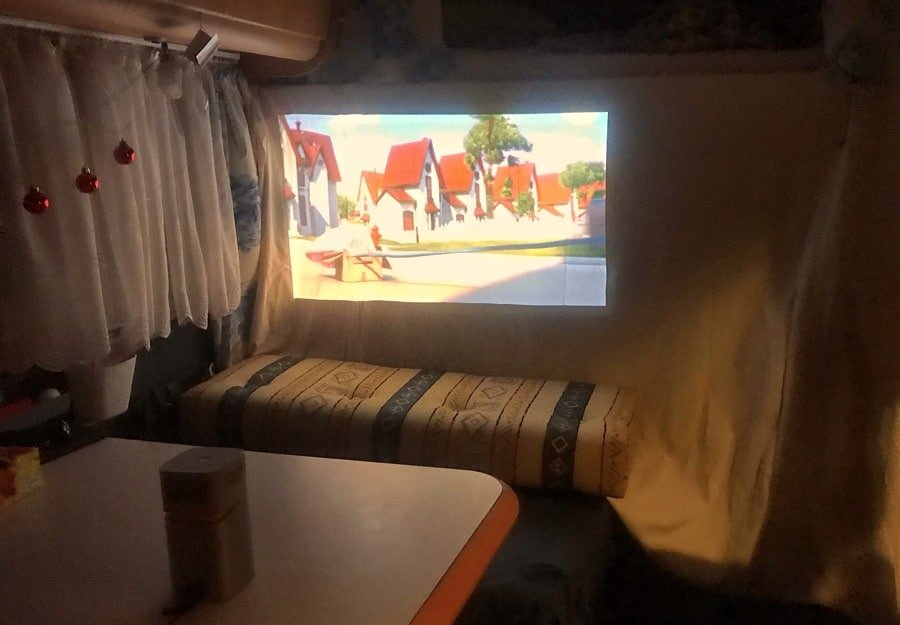
Unlike most home or office projectors, it has a camera tripod mount rather than the more common teeny weeny bolts. This is a great idea, and simple to use. The picture is adjustable for upside down mounting.
Operating System and Ease of Use
The user interface is through a selection of on-screen menus and tabs powered by an Android operating system. The thing is pretty simple and intuitive as far as it goes, but it begs some questions. For example, there is a native media player – but this only works when the GV1 is hard wired through its USB-C DisplayPort or with a USB-C flash-drive. Unfortunately, it reports unknown media type so far on most of the media I have tried to show, which is why I use VLC. When I have used the native player, I can’t find any lip sync adjustment control.
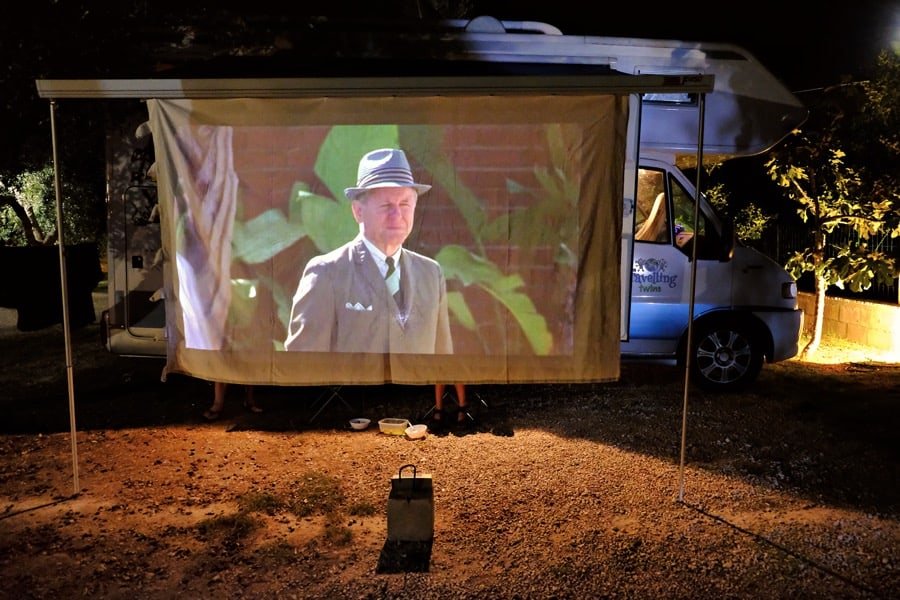
It has 5 GB of onboard memory but I can’t reach that by USB cable or wireless connection to my laptop. I did manage to put a movie into that memory by downloading a network file manager and using wifi to link to my home file server – but that’s not a viable solution for travel. In any case, a movie shown from the internal drive is no better than one shown from a pen drive.
The Android system doesn’t have Google Play. It does have an independent app store called Aptoid This works fine and offers apps such as VLC media player, Netflix, Youtube and the file manager I mentioned above. Of these, only VLC is relevant to life on the road. The others work well with our home Wifi network.
BenQ GV1 – Design for Travel
The LED lamp is a great idea. This means it runs cool. The colour is good and we don’t have to wait ten minutes for the lamp to cool down before moving it after use.
It comes with a sleek little remote control. There is no lens cap of any kind. There is a drawstring kitbag which frankly is a silly accessory – is anyone going to sling this over their shoulder to go for a jolly binge-watch weekend with no other luggage? The drawstring bag is a tight fit, It certainly doesn’t stow the adaptor plug and I’m wary of damaging the remote by trying to squeeze that in next to the projector. If you lose the remote you can’t do anything. We repack ours in the cardboard box after use every time which is tedious.
Here is my free advice to the manufacturers for a future GV1 Mark II.
- Add a sliding captive lens cap.
- Make the remote control store and dock into a recess in the side of the main unit (bonus – with a recharger function).
- Include a simple drop-resistant case to carry the unit, the plug and the remote. (or even make this available as an optional extra)
- Either provide a standard full size USB port or else include a USB-C pendrive in the hardware supplied.
- Make a storage dock in the side of the main unit for the pendrive too.
One peculiar thing is that the literature says that the internal battery is good for 300×3 hr cycles. Am I going to throw this machine away after watching 500 movies? I guess so. No doubt by then, a battery replacement would cost more than a new projector.
Edit after three months. The battery has already failed. If you forget to or for some reason can’t charge it immediately before a performance then you have to plug it into the power to show a movie.
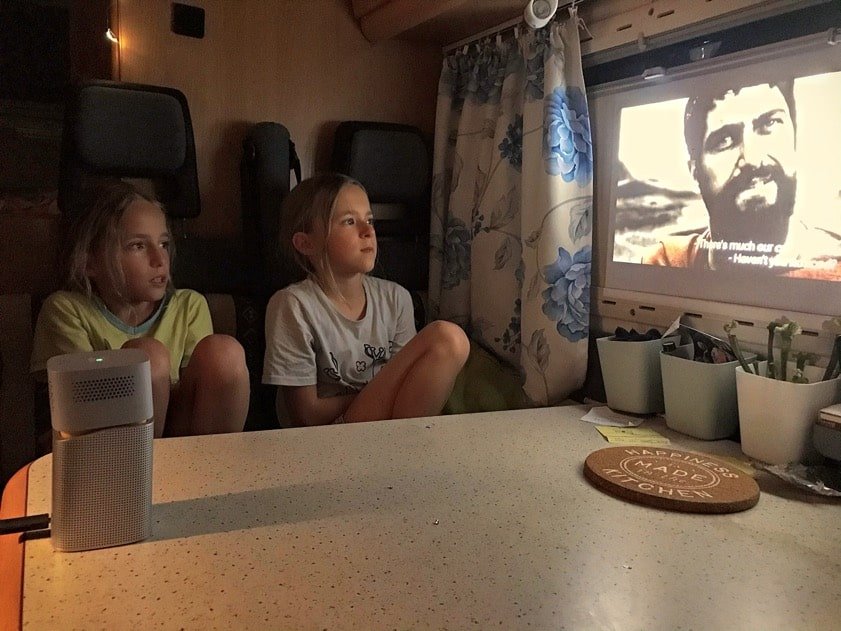
Documentation
The quick start guide has the usual safety warnings and drawings of the unit and then is composed of little screenshots which are too small to see. What the quick start guide should say is this:
- Charge this thing before leaving home (it takes 3 hours)
- Update the firmware before you stray from broadband (another twenty minutes if your broadband is fast, much more otherwise)
- Download and install VLC and your favourite media apps at the same time.
- Put the GV1 back in its box until you have bought a USB-C pen drive
- You might like to think about buying a new laptop – one with USB-C “DisplayPort”
It’s easy to find the full user manual on the web, but you don’t need it. As one of the few people in the world who actually reads these things, I can report that it doesn’t say anything more useful than describing the onscreen menus. These are pretty self-explanatory anyway and the manual doesn’t tell you anything new.
Connectivity
Introduction
The BenQ GV1 is sold as WiFi and Bluetooth device and can even create its own hotspot access point. This is all well and good but it doesn’t have the wireless functionality you actually need to show movies if you are away from your home Wifi.
Unless you are pretty geeky you can skip the rest of this section, buy a USB-C Flash Drive and start again at the section titled “USB-C Flash-Drive” below.
Physical Ports
The only physical port is one USB-C socket and according to the documentation, it is enabled for DisplayPort connection. I had never heard of DisplayPort so I did an internet search and checked my hardware. This apparently is the super new standard – it’s better than HDMI. Only trouble is, it’s so whizzbang new that it’s not compatible with anything else we own. My Dell laptop is only one year old and has an intel 8th generation Core-i7 chip which I was assured was so super new that it would light up the skies. However when I dug out a cable which connects the USB-3s on my laptop with a USB-C plug at the other end it neither allowed the projector to access media on the computer not did it allow the computer to write a video file onto the projector’s internal memory. So it seems that my whizzbang Dell doesn’t have DisplayPort. Everything else we own is a year or more older than my laptop, so no point in trying to find DisplayPort on any of them then . . .
There is an HDMI logo on the back of the Quick Start Guide. I have no idea why, because there is no HDMI or mini HDMI port on the machine. The BenQ website says that HDMI adapters don’t work either with the USB-C DisplayPort. I guess the HDMI logo was a misprint!
Summary so far. I can’t link this machine by cable to any hardware I possess.
So we bought a USB-C pen drive before leaving home in Poland. This cost a bit more than PLN 50, say GBP 10 or US$ 12. This means we can at last put a movie on that pen drive and then show the movie with the pen drive plugged into the USB-C port on the back of the unit. To cut a long story short: this USB-C is the ONLY way forward.
About USB-C Generally
Now I think this is an overdue welcome format change. The Android-style mini USB plug is just plain annoying because it shares the original USB plug characteristic of being asymmetrical but difficult to see which way up it goes. Yes, I will be happy when everything is USB-C shaped but until then, why on earth, Mr BenQ, do you not make this new toy compatible with other hardware in the real world? Before we bought the USB-C stick, I couldn’t even plug one of our dozen flash drives into this brick!!
So maybe provide a full USB port like every other media player I have seen; OR bundle a conversion cable; OR bundle a USB-C flash drive; OR give me a downloadable app which will allow me to use the hotspot access point to put a video file on the thing’s internal memory. OR do anything else which would have saved us a week of trial and error during that important first-impressions stage after buying a new toy.
OK so we bought the USB-C flash drive and that works, though some movie formats are significantly more jerky played through the projector than when shown on laptop. Meantime I also tried wireless connectivity but it’s a big disappointment.
Wifi Casting/Mirroring
So I connected it to our home Wifi and updated the firmware (all of which works fine) the next thing was to see what I could connect it to using Wifi. The native Android operating system tells you how to use wifi to mirror the screen on your iPhone iPad Macbook, Android or PC. This all works ok so long as you don’t want to watch movies. Erm but as it happens that’s almost the only thing I do want to do with this machine!
The problem with watching movies by casting or mirroring from anything other than a PC is that you will be looking at a very jerky low quality picture which is much less of a joy to watch than the screen it is mirroring. Yes: my family, and I suspect anyone with eyes, would rather huddle round an iPad than watch the mirrored output of this projector.
Casting from a PC is even worse. The only way I could find to mirror the screen from my Windows 10 laptop was to fire up Chrome and find “Cast” in the options menu. This works with the same rubbish functionality as the other platforms with an added extra. You cast the screen and you cast the sound too, including the volume! So you either have no sound or you get the soundtrack twice, with a lag between the two. There are other even more flaky quirks with the Chromecast function too but I won’t describe them because it just makes me angry that someone with BenQ’s reputation could make it so bad, and I won’t be using this “Cast” function again.
The computer seems to offer me other ways to link to a wireless device and the only problem here is that after three hours trying, I couldn’t find out how to use them. Sure they pop up and offer themselves but I could neither get them to work, and nor could I find out how to do so on the web. I can report that the manual is no help here either. As an added dead end and frustration, Chrome also offers the option of “playing files” by casting, except it doesn’t recognise any videos or music files sitting large as life on my laptop HDD as being compatible.
A couple of other random things about casting/mirroring: One internet reviewer rather more tech savvy than me, said that screen mirroring works for some of his collection of Android Phones but not others. It works from my three-year-old Samsung insofar as you can say it works at all.
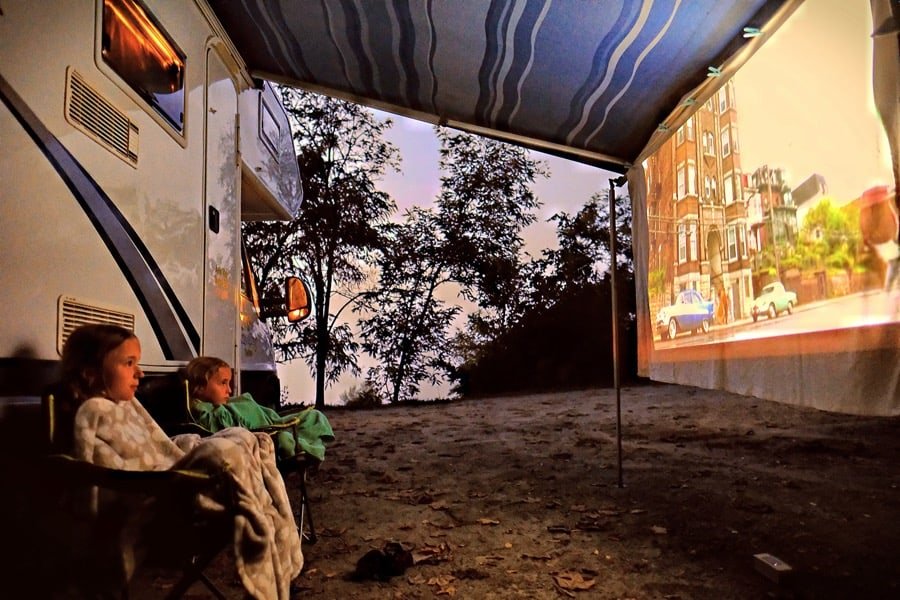
One small positive is that casting DOES work away from home Wifi by linking the mobile device to the GV1’s own Wifi hotspot Access point. So if you like your movies jerky and fuzzy or perhaps if you want to show powerpoint slideshows in someone else’s office then do indeed use that hotspot function. I couldn’t find another use for the hotspot though.
Wifi Without Casting/Mirroring
I wondered whether I could use my laptop as a fileserver? The onboard browser only works with the USB-C stick or allegedly with the USB-C DisplayPort hard wire link. So I downloaded VLC media player and installed it on the machine. This was a small breath of fresh air in a frustrating week. While on my home Wifi, I could now browse through VLC to my NAS (network fileserver) and watch a movie. Yippee. Now, this was the only way (before we bought a USB-C pendrive) That we managed to watch movies on this machine . . . Problem was: I wouldn’t be taking my home router, access point, and fileserver or the power station to keep them running on any road trip.
I once managed to get wireless access to the movies stored on my laptop HDD too. If you go to Control Panel/Network and Sharing Center in Windows 10, there is an obscure little link in the sidebar saying “media streaming options.” Go down this rabbit hole and make everything available for network access. It worked once though my home wifi (ie I could see and play files on my laptop through VLC on the projector) but then it didn’t any more. I tried it half a dozen times since with no result. Again this was academic unless we would be taking our mains powered TP-Link home router with us on the trip – and even if we did, who wants flaky movie nights on the road at kid’s bedtime!
Of course I also tried using the GV1’s Hotspot Access point to locate media files using VLC’s browser, but íf you’re not on an external wifi network it doesn’t see anything except the unit’s own 5GB internal memory, of which 4GB was free.
I used Aptoid to download and install a file manager. It took a few tries installing different file managers before I found one which could browse over Wifi to find one of my network file-servers. At last, I successfully copied a movie which VLC could still find on the unit’s internal drive after I disconnected the Wifi. OK that was tedious and slow but it worked. However it’s not a solution for travel. 4GB is not enough for six months of movie nights so I would have to repeat the exercise every couple of shows. And I’m not taking my home network and server on the road, remember! And iif I were, I could stream from it direct.
Wireless Connection Summary
Summary of all the above: Unless you are on a good wifi system, either with Netflix or YouTube or a fileserver with video files, then the Wireless connectivity is of no practical use other than downloading firmware updates.
Wireless postscript.
Just thinking aloud here. I’m sure that my laptop is capable of sending stuff out to this machine, for example the new GV1 has already found its way into a list called “Other Devices” under a Windows 10 control tab called “Bluetooth and Other Devices” There it is . . . but with no functionality I can get at! I wonder whether Android has twisted Benq’s arm and insisted that Chrome mirroring is the only way . . .?
I think somebody could surely fix this with an app which picks up on everything difficult clunky or obscure and make it work simply and reliably I have a nice little app that does this kind of thing across all platforms for our HP wireless printer/scanner, and something similar for our TP-Link home router.
USB-C Flash-Drive
OK the simple summary of EVERYTHING to do with connectivity in this article so far is this: If you are away from fast broadband wifi and a proper fileserver the ONLY way forward is to buy a USB-C drive and also take a laptop with you to keep the pendrive stocked up with media beyond its own capacity.
Summary of Connectivity and Operational Issues
Even with the USB and when using a nice bluetooth external speaker, AND having downloaded VLC media player, some media formats are a bit jerky visually (less smooth than on the laptop also using VLC as the media player) AND if using an external speaker there are lip-synch issues which, despite promising menus within VLC, don’t ever seem to go away.
Who Is the BenQ GV1 Designed For?
I have been wondering who would want to pay more than GBP 300 for one of these things.
I spent quite a bit of my pre-travel career as an Architect giving presentations in client’s boardrooms, and sometimes we had problems trying to hook my laptop to their projector in the ten minutes between being given access to the room and before the client rocked up. I guess having one of these babies in my briefcase might have given me a plan-B when showing powerpoint projections with no movies.
Maybe kids can take it for sleepovers at their friends house to show movies on the bedroom ceiling so long as they have a USB-C pen drive in their pocket and aren’t the kind of kids who lose pendrives or remote controls.
Or maybe for gaming? Maybe games machines all have USB-C functionality these days?
For us on a camper trip it is great for movie nights projecting onto a white window blind inside the van using the internal speaker, or outside the van (mosquitoes and/or moonlight and/or wind permitting) using a suspended bed-sheet for a bigger picture.
Bottom Line
We were given this unit. With our GV1 we watch movies on the road on a bigger screen than a laptop. We couldn’t do that otherwise. Ania and the girls think it is great, and I love the movie nights too, but it grates with me that both the sound and connectivity could and should both be better than they are.
The machine is also miserably unreliable. The first one failed after about five or six movies, BenQ provided a replacement. After a few months of use, the battery in the second one can’t hold its charge for a day.
If we had paid GBP 300 for it, I would have a sour taste in my mouth.
BenQ GV1 – Projector for travellers – Pin it for later

Disclaimer
We were given our GV1 projector (and when it broke down its replacement -for which we paid international carriage both ways) for the purpose of an unbiased review — our general policy is only to review products we genuinely like and find useful. We have rejected review offers from companies who do not meet these criteria.
In the present case, I like BenQ products generally and this machine has served a use in combination with third party hardware. Do I like it? Yes. But.
I have not posted a dedicated link for this projector because as it stands I am lukewarm about recommending that you buy one, so that would seem a bit inconsistent. However if you do want to buy one of these or anything else through Amazon then please use my link . . .
This website uses affiliate links for income and support. If you like our website please consider using these links. You will be directed to the vendor and we will get a small commission on your purchase price at no increased cost to you.
We have researched facts stated here as far as practicable but please check anything critical before committing your time and money. It is quite possible that we have missed some functionality of the machine or VLC software we have reviewed here and if you find something please comment below.
We do not claim any special knowledge or expertise, and we are not acting as consultants for our readers.